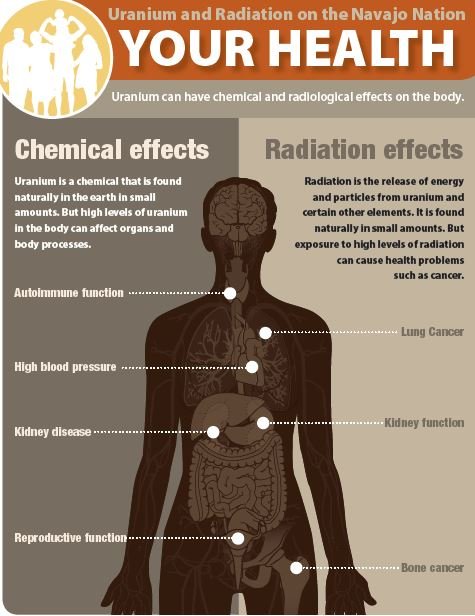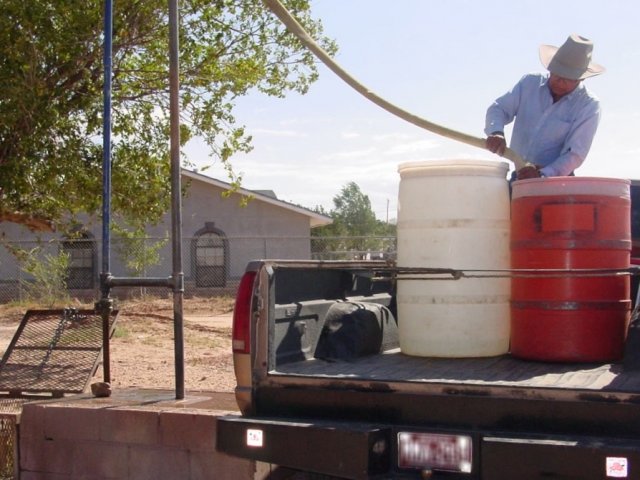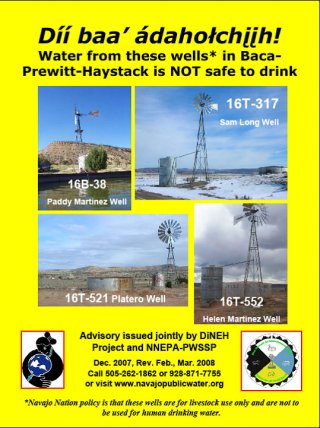Health Effects of Uranium
Overview
Uranium is a metal that exists naturally in the earth. There are small amounts of uranium in almost all the soil, rock, and water in the world. It can move through the environment in rain, wind, and other natural processes. People have used uranium for building military shielding, weapons, planes and helicopters. It’s also used to fuel nuclear weapons and nuclear power plants.
People can come in contact with uranium, radiation, or both on the Navajo Nation by spending time at abandoned uranium mines, living in a home that was built with material from a mine or mill site, drinking unregulated water, or not following good water hauling practices. Everyone comes in contact with low levels of uranium because it’s in the environment. But coming in contact with higher levels of uranium can be harmful to your health.
The documents below provide information about uranium, how you can avoid contact with it and how it can affect your health.
Safe Drinking Water
The federal government and the Navajo Nation are working together to increase access to safe drinking water by extending public water systems to serve homes without piped water and by making safe drinking water more accessible for residents who continue to haul water. Recent (2020) estimates suggest that approximately 15% of the population on the Navajo Nation still do not have access to piped water to their homes.
Background
In 2003, the Navajo Nation estimated that up to 30% of the population did not have piped water to their homes. Since 2003, the Indian Health Service (IHS), EPA and HUD have worked cooperatively to provide access to safe drinking water for over 3,000 homes in the abandoned uranium mine regions of the Navajo Nation. This has helped lower the percentage of the population without access to piped water to their homes to about 15%. Navajo Tribal Utility Authority (NTUA) and IHS have also added new regulated water hauling points and upgraded existing watering points throughout the Navajo Nation.
Without piped water, residents haul water either from regulated watering points or from unregulated water sources, such as livestock (windmill) wells and springs. The number of unregulated water sources on the Navajo Nation is estimated to be in the low thousands.
The Navajo Nation Environmental Protection Agency (NNEPA) policy prohibits the use of unregulated water sources for human consumption because these sources are not routinely tested and regulated under the Safe Drinking Water Act (SDWA). These unregulated water sources are susceptible to bacterial contamination, including fecal coliforms. Some of these unregulated water sources also exceed drinking water standards for uranium and other chemicals, including naturally occurring chemicals. Nevertheless, human consumption of unregulated water is reportedly widespread due to a lack of regulated water systems in the more remote and sparsely populated regions of the Navajo Nation.
Residents are encouraged to haul water from a regulated water source that is known to be safe. Water from livestock (windmill) wells are for livestock use only.
The rural terrain and sparse population in many areas pose unique challenges for traditional piped water solutions. IHS estimates that it will cost over $700M to provide access to safe drinking water and basic sanitation to all Navajo homes. The Navajo Nation and the federal agencies continue to work together to implement novel approaches to address this vitally important issue.
How to Safely Haul and Store Drinking Water
Only regulated water sources are safe to drink because they are routinely sampled and regulated under the Safe Drinking Water Act (SDWA). Please visit the NNEPA Public Water Systems Supervision Program website for more information on drinking water.
Fact Sheets
-
Uranium 101 Presentation in Navajo: Diné Bikéyahgi Łeetsoh Hólónígíí – Nát’aą́ ’Náháne’, Bée’ádááh & Ats’íís Yeiinít’įįh́́ yeiinít’įįh (pdf)
Learn More: Community Outreach Network - Learn the Basics: Uranium and Radiation on the Navajo Nation (pdf)
- Reduce Your Contact: Uranium and Radiation on the Navajo Nation (pdf)
- Your Health: Uranium and Radiation on the Navajo Nation (pdf)




